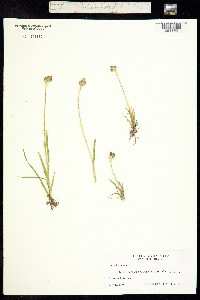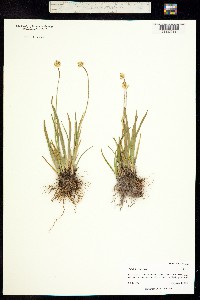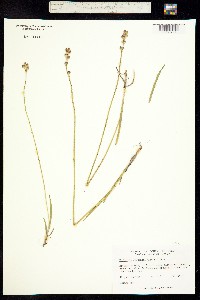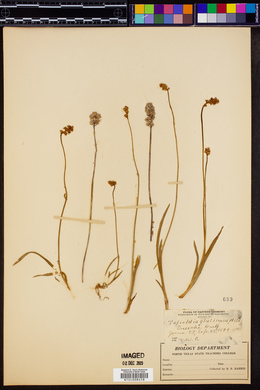Triantha glutinosa
|
|
|
|
Family: Tofieldiaceae
Sticky False Asphodel
[Tofieldia glutinosa (Michx.) Pers., moreTofieldia glutinosa subsp. glutinosa (Michx.) Pers., Tofieldia glutinosa var. glutinosa] |
Stems leafless, or with 1-3 leaves toward base, 5-50 cm, glandular below inflorescence, glands dome-shaped to conical, 1/2-2 times longer than wide, rarely glandular-pubescent with coarse cylindrical hairs. Leaf blades to 30 cm × 6 mm. Inflorescences forming cylindric-ovate spikelike heads, 3-30-flowered, sometimes interrupted or open, 1-6.5 cm, glandular-pubescent; bracts subtending pedicel in cluster; bracteoles forming ascending, truncate, or shallowly 3-lobed involucre around pedicel, lobes spreading, occasionally cleft from proximal 1/3 to base, narrow, usually glabrous, margins usually entire or nearly so, apex rounded to acute. Flowers borne in clusters of 3, proximal sometimes remote; perianth white or yellowish; tepals 3.8-5 mm, inner series slightly longer; stamens 2.8-4 mm; ovary ellipsoid, tapering gradually to style base; styles distinct, 0.6-1.5 mm; pedicel 1-9 mm. Capsules ovoid to broadly ellipsoid, 3.5-7.5 mm, clearly longer than tepals and not enclosed by them, chartaceous, easily ruptured. Seeds reddish brown, ca. 1 mm; appendages 2, one at each end of seed, one contorted, 1-4 times longer than seed, other at opposite end, much shorter; coat absent. Flowering summer. Marshes, wet meadows, calcareous soil; 0--2100 m; St. Pierre and Miquelon; Alta., B.C., Man., N.B., Nfld. and Labr., N.W.T., N.S., Ont., Que., Sask., Yukon; Alaska, Ill., Ind., Maine, Mich., Minn., N.H., N.Y., N.C., N.Dak., Ohio, Oreg., Tenn., Vt., Va., W.Va., Wis. Hybrids between Triantha glutinosa and T. racemosa occur in Burlington County, New Jersey; see note under T. racemosa. On the Queen Charlotte Islands in British Columbia, there appears to be some evidence of hybridization between T. glutinosa and the two subspecies of T. occidentalis that occur there.
Perennial herb with a rhizome flowering stem 20 cm - 0.5 m tall Stem: very sticky-hairy in the upper part. Leaves: mostly basal, overlapping, two-ranked, 8 - 20 cm long, to 8 mm wide, linear. Sometimes there is a single bract-like leaf near the middle of the stem. Inflorescence: an upright, terminal, dense cluster (raceme), 2 - 5 cm long. Flowers: two or three at each node, on sticky-hairy stalks, white, to 6 mm long, with six distinct tepals. Tepals 4 - 5 mm long and reverse lance-shaped. Stamens six. Fruit: a papery capsule, 5 - 6 mm long, egg-shaped. Seeds reddish brown. Similar species: No information at this time. Flowering: late June to early October Habitat and ecology: Local in moist calcareous areas, including bogs and marshes. Occurence in the Chicago region: native Notes: Flora of North America currently recognizes the genus Triantha, therefore calling Tofieldia glutinosa by the name of Triantha glutinosa. These names are here considered synonymous. See the link below for further information. Etymology: Tofieldia is named after Thomas Tofield, an 18th Century botanist. Glutinosa means sticky. Author: The Morton Arboretum Basal lvs several, 8-20 cm, to 8 mm wide; cauline lf usually single and bract-like, near the middle of the stem, or absent; scape 2-5 dm, very sticky-hairy upwards, the raceme 2-5 cm; fls white, 2 or 3 together at each node, on sticky-hairy pedicels 3-6 mm, each subtended just below the perianth by small ovate bractlets; tep oblanceolate, 4 mm; fr ovoid, thin- walled, 5-6 mm; seeds fusiform, the body 1-1.3 mm, with a filiform contorted appendage at each end. Moist or wet places; Nf. to Alas., s. to N.Y., Ind., and Calif., and in the mts. to W.Va. and N.C. July. (Triantha g.) Our plants are var. glutinosa. Gleason, Henry A. & Cronquist, Arthur J. 1991. Manual of vascular plants of northeastern United States and adjacent Canada. lxxv + 910 pp. ©The New York Botanical Garden. All rights reserved. Used by permission. From Flora of Indiana (1940) by Charles C. Deam Found in wet, marly soil in a few marshes and springy places in the northern counties. Local and, where found, sometimes frequent over the entire area of its habitat. …… Indiana Coefficient of Conservatism: C = 10 Wetland Indicator Status: OBL |
|
|
|





























































































